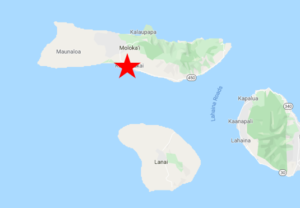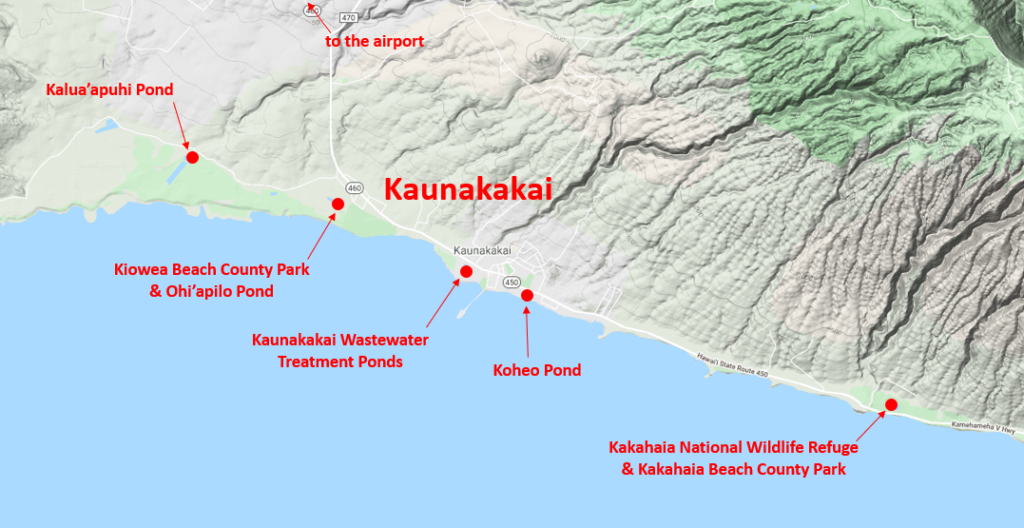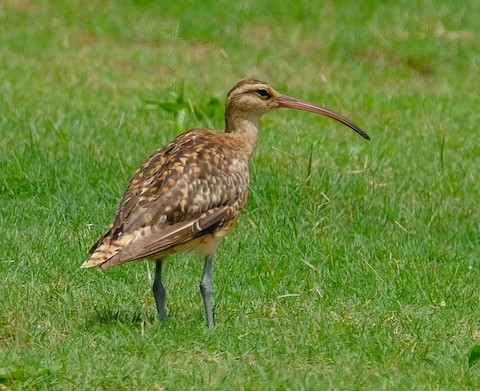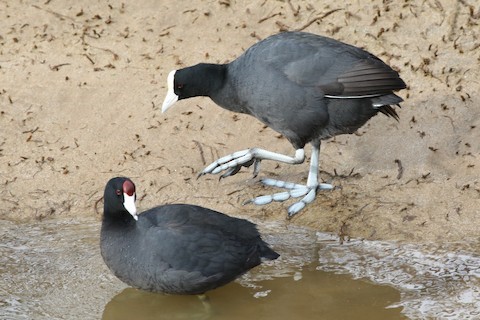Kaunakakai, Molokai, Hawaii

Early Hawaiians engaged in extensive aquaculture along the southern coast of Molokai, altering the landscape by constructing an extensive chain of fishponds. Most have apparently breached and fallen beneath the waves, but a few remain and now support waterbirds, including Hawaiian Coot, “Hawaiian Stilt”, and various migratory waterfowl and shorebirds, including Bristle-thighed Curlew. The brushy areas around them are dominated by introduced landbirds, including California Quail, Black and Gray Francolins, White-rumped Shama, African Silverbill, and Scaly-breasted Munia.
Orientation
Directions
Kaunakakai is the largest town on Molokai, about seven miles southeast of the airport on the main road, the Kamehameha V Highway.
Birdfinding
The southern coast of Molokai is productive for waterbirds, including two endemics—Hawaiian Coot, “Hawaiian Stilt”—and the largely Polynesian Bristle-thighed Curlew. Regularly occurring vagrants include White-faced Ibis and Sharp-tailed Sandpiper.
Six spots to check in the vicinity of Kaunakakai, from west to east:
Kalua’apuhi Pond. Three miles west of Kaunakakai on Kaunakakai Road, are two old fishponds, now lagoons lined with mangroves, Kalua’apuhi and O’o’ia. The habitat is productive, but the access and visibility are poor. To the west of them is a small complex of managed ponds—collectively the Molokai Sea Farm—which is a traditional spot for flocks of shorebirds including “Hawaiian Stilt” and Bristle-thighed Curlew.
Kiowea Beach County Park. One and a half miles west of Kaunakakai on Hoawa Road are two ponds, one that usually has standing water and one that is usually bare mud. The wet one, Ohi’apilo Pond, is a consistent place for several wintering ducks, including Northern Shoveler, Northern Pintail, and Green-winged Teal, and has produced several records of White-faced Ibis, along with the more expected Black-crowned Night-Heron and Western Cattle Egret. The surrounding brush often produces, among other things, Black and Gray Francolins and White-rumped Shama.

Kaunakakai Wastewater Treatment Ponds. Within Kaunakakai, about a quarter-mile west of the harbor, the wastewater treatment ponds tend to attract several species of shorebirds. Notable vagrants have included Sharp-tailed and Curlew Sandpipers and White-winged Tern.
Koheo Pond. Also within Kaunakakai, about a half-mile east of the harbor, directly across the highway from Maui Community College, Koheo Pond is another site that often attracts shorebirds, including Bristle-thighed Curlew, Whimbrel, Ruddy Turnstone, Sanderling, and Wandering Tattler. Immediately west of the community college are the athletic fields of Duke Maliu Regional Park, which is the most consistent spot on Molokai for Bristle-thighed Curlew.
Kakahaia National Wildlife Refuge. About five miles east of Kaunakakai along the Kamehameha V Highway is Kakahaia. The main attraction is Kakahaia National Wildlife Refuge, which protects the Kakahaia Pond complex, with resident populations of Hawaiian Coot and “Hawaiian Stilt”, and migratory shorebirds and waterfowl. The refuge itself is fenced and not publicly accessible, but visitors can park at Kakahaia Beach County Park and view the pond complex from several vantage points, including the picnic area. Adjacent brushy areas often hold California Quail, Black and Gray Francolins, African Silverbill, and Scaly-breasted Munia.
Halawa Beach County Park. Continuing east 22 miles on the Kamehameha V Highway to its terminus will bring you to Halawa Beach County Park, the northeasternmost accessible location on Molokai. About one mile prior to the park, the highway rounds a headland with tall, steep, clifflike walls. Red-tailed Tropicbird nests somewhere on these hillsides and can be seen from February until at least May and likely later, depending on their nesting success.
Notes
When to Visit
The peak season for unusual migrants and vagrants is roughly October to March or April.


